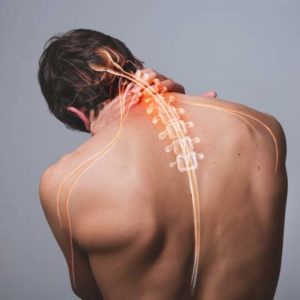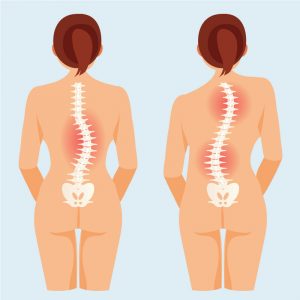Last Modified on August 30, 2024 by Dr. Tyler Meier

A holistic pain management and spinal health approach is essential for long-term wellness. This methodology focuses not only on symptomatic relief but also on identifying and addressing the underlying etiology. By integrating spinal manipulations, therapeutic exercises, and lifestyle modifications, we aim to target pain at its source while improving overall spinal health. This comprehensive strategy offers immediate alleviation of symptoms and preventive measures against future complications, promoting sustained health and functionality.
Understanding Pain and Spinal Health
Pain Physiology
Pain is a crucial neurological warning system, alerting the body to potential harm or dysfunction. In spinal health, pain can indicate various underlying conditions affecting the vertebral column, associated musculature, or neurological structures.
Spinal Anatomy and Function
The spine, composed of 33 vertebrae, intervertebral discs, and supporting ligaments and muscles, plays a vital role in structural support, mobility, and spinal cord protection. Maintaining optimal spinal health is paramount for overall physiological function and quality of life.
Classification of Pain
Pain can be categorized based on duration and etiology:
- Acute Pain: Typically lasting less than three months, acute pain often has an apparent precipitating factor and serves a protective function.
- Chronic Pain: Persisting beyond three months, chronic pain can significantly impact a patient’s physical and psychological well-being.
Common spinal pain presentations include:
- Lumbar pain (most prevalent)
- Cervical pain
- Radicular pain (e.g., sciatica)
Etiology of Spinal Pain
Spinal pain can arise from various sources:
Common Etiologies
- Traumatic injuries
- Postural dysfunction
- Degenerative conditions (e.g., osteoarthritis, degenerative disc disease)
Underlying Pathologies
Spinal pain may be indicative of more severe conditions such as herniated intervertebral discs, spinal stenosis, or neoplastic processes.
Diagnostic Approach
A thorough diagnostic workup is essential for developing an effective treatment plan
Diagnostic Modalities
- Radiographic imaging: Provides visualization of bony structures and gross spinal alignment
- Magnetic Resonance Imaging (MRI): Offers detailed evaluation of soft tissues, including intervertebral discs and neural structures
- Computed Tomography (CT): Provides three-dimensional imaging, particularly useful for assessing complex bony anatomy
In addition to advanced imaging, comprehensive physical examinations and patient history are crucial components of the diagnostic process.
Importance of Accurate Diagnosis
Precise diagnosis is fundamental to developing targeted treatment strategies and avoiding unnecessary interventions.
Treatment Modalities
Following accurate diagnosis, a multifaceted treatment approach can be implemented:
Conservative Management
- Pharmacological interventions: May include analgesics, anti-inflammatories, or muscle relaxants as appropriate
- Physical therapy: Focused on improving strength, flexibility, and functional capacity
- Chiropractic care: Utilizing spinal manipulations to address biomechanical dysfunctions
Surgical Interventions
It is reserved for cases unresponsive to conservative measures or presenting with severe neurological compromise.
Complementary Therapies
- Acupuncture: May modulate pain perception through neuromodulation
- Massage therapy: Can address myofascial components of pain
Lifestyle Modifications for Spinal Health
Preventive strategies play a crucial role in maintaining spinal health:
Exercise and Physical Therapy
Regular physical activity is essential for spinal health. Recommended activities include:
- Aquatic exercises: Provide low-impact conditioning
- Yoga: Improves flexibility and core strength
- Aerobic activities: Enhance overall cardiovascular health and promote nutrient delivery to spinal structures
Nutrition and Diet
Proper nutrition supports spinal health:
- Calcium and Vitamin D: Essential for bone health
- Anti-inflammatory foods May help manage chronic pain conditions
- Adequate hydration: Supports intervertebral disc health
Ergonomics
Optimizing workplace ergonomics can significantly impact spinal health:
- Proper seating: Supports natural spinal curvatures
- Regular postural adjustments: Prevents prolonged static positioning
- Ergonomic workspace design: Minimizes biomechanical stress on the spine
Case Studies
Case 1: Chronic Lumbar Pain Management
Patient: 45-year-old female, presenting with chronic lower back pain Intervention: 6-month multimodal treatment plan including physical therapy, lifestyle modifications, and targeted exercises Outcome: Significant pain reduction and improved functional capacity
Patient Testimonial
“The comprehensive approach to my spinal health has dramatically improved my quality of life. I’ve regained my ability to participate in activities I previously thought impossible due to pain.” – Daniel, a 62-year-old male.
A comprehensive pain management and spinal health approach is fundamental to long-term well-being. We can facilitate sustained pain relief and optimize spinal function by addressing both symptomatic manifestations and underlying etiologies. This holistic strategy enables patients to maintain an active, pain-free lifestyle while minimizing the risk of future complications.
Learn more about our treatments here!
Frequently Asked Questions
How long does pain treatment typically take?
Treatment duration varies depending on the pain source, severity, and chosen approach. Consult a healthcare professional for a personalized estimate. Recovery can be accelerated through active participation in treatment and self-care practices.
Does insurance cover pain management?
Insurance coverage for pain management varies by plan. Contact your provider to verify coverage details. Many healthcare professionals offer flexible payment options or can help navigate insurance processes.
Is pain management suitable for children or seniors?
Pain management strategies can be adapted for various age groups. Gentle techniques and modifications ensure safety and address specific needs. Consult a healthcare professional to discuss the most appropriate approach for your age.
Can pain management be combined with other therapies?
Absolutely! A mix of pain management methods can help. They include physical therapy, massage, and acupuncture. This approach makes for a well-rounded treatment plan. Discuss your options with a healthcare professional to create a personalized approach that addresses your unique needs.
Are there any side effects or risks associated with pain treatments?
Pain management approaches vary in potential side effects. Consult a healthcare professional for a comprehensive discussion of risks and benefits specific to your chosen treatment plan. Open communication ensures you make informed decisions about your pain management journey.

Dr. Tyler Meier is a board-certified, licensed chiropractor and founder of CorePosture Chiropractic in Newport Beach, CA







